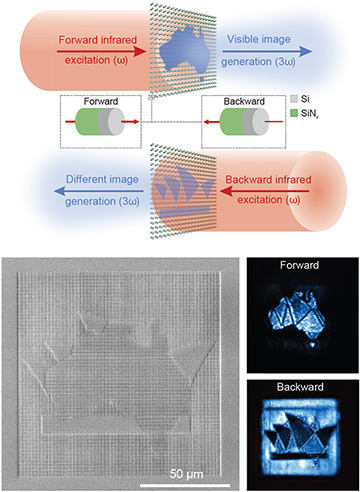 Top: Directional image generation at the third-harmonic frequency with a dielectric metasurface. The set of asymmetric nanoresonators on the metasurfaces induces strong magneto-electric coupling between the Mie modes, leading to asymmetry in the nonlinear optical response. Bottom left: Electron microscope image of a fabricated sample. Bottom right: Experimentally observed images at the third-harmonic frequency for both forward and backward illumination. [Enlarge figure]
Top: Directional image generation at the third-harmonic frequency with a dielectric metasurface. The set of asymmetric nanoresonators on the metasurfaces induces strong magneto-electric coupling between the Mie modes, leading to asymmetry in the nonlinear optical response. Bottom left: Electron microscope image of a fabricated sample. Bottom right: Experimentally observed images at the third-harmonic frequency for both forward and backward illumination. [Enlarge figure]
The field of dielectric metasurfaces has seen tremendous progress in just a few years, going from fundamental concepts1 to mass-fabricated consumer products. Passive and linear dielectric metasurfaces have started replacing conventional bulky optical components in commercial devices.
An important class of functionalities not yet addressed with metasurfaces, however, involves asymmetry in both the generation and transmission of light with respect to reversals of the positions of emitters and receivers. Many optical processes—including refraction, diffraction, mode conversion and polarization conversion—obey symmetry.2 Nonlinear optics is one of only a few pathways toward asymmetric control of light. It is also, at present, the most technologically feasible pathway to miniaturize such control to the nanoscale.
In recent work, we demonstrated asymmetric parametric generation of light in nonlinear metasurfaces.3 We assembled the metasurfaces from a set of four dissimilar dielectric resonators. The resulting layouts produced images in the visible spectral range on being illuminated by infrared radiation via a third-harmonic generation (THG) process. By design, the metasurfaces produced two different, independent images for opposite directions of illumination.
Each nanoresonator was a bilayer cylinder made of silicon and silicon nitride materials. Two overlapping resonances—the electric-dipole and magnetic-dipole Mie modes—dominated the resonators’ response. The difference in the refractive indices between silicon and silicon nitride induced strong magneto-electric coupling, leading to THG dependency on the direction of excitation.
In the work, we developed four types of resonators: a resonator producing bright THG for forward illumination and dark THG for backward illumination; dark for forward and bright for backward; bright for both forward and backward; and dark for both forward and backward. The metasurfaces were fabricated with electron beam lithography and experimentally tested with a pulsed laser system at an excitation wavelength of around 1.5 µm.
As light passes through the metasurface, an image of Australia can be seen. When the metasurface is flipped, an image of the Sydney Opera House becomes visible. The demonstrated “traffic control” of light via asymmetry in parametric generation also points in the direction of self-induced nonlinear nonreciprocity in nanoscale optics, which should lead to numerous practical devices including isolators, circulators and directional power limiters.
Researchers
Sergey S. Kruk and Yuri Kivshar, Australian National University, Canberra ACT, Australia
References
1. S.S. Kruk and Y. Kivshar. ACS Photon. 4, 2638 (2017).
2. C. Caloz et al. Phys. Rev. Appl. 10, 047001 (2018).
3. S.S. Kruk et al. Nat. Photon. 16, 561 (2022).
